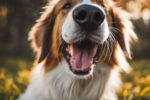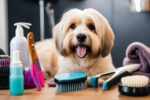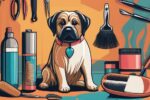Grooming Tips for Senior Canines: Keep Your Aging Pet Looking and Feeling Their Best
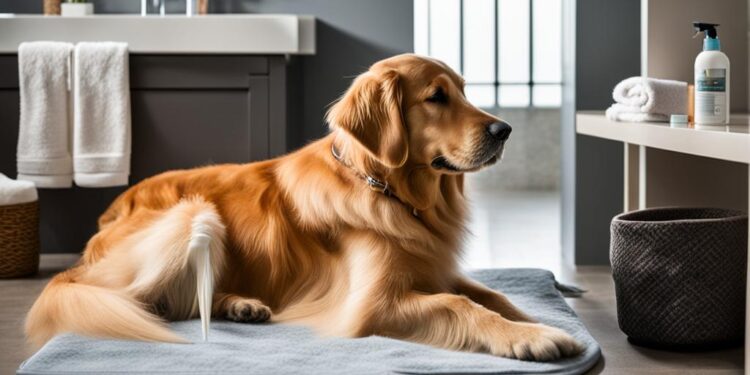
As our canine companions reach their golden years, they require special care and attention to maintain optimal health and comfort. Proper grooming is essential for senior dogs, but it is important to approach it with compassion and adaptation to their unique needs.
In this article, we will cover expert tips on grooming for senior dogs, including understanding the special needs of aging pets, creating a gentle grooming routine, and addressing mobility and anxiety issues. By following these guidelines, you can ensure your beloved pet looks and feels their best in their later years.
Understanding the Needs of Senior Dogs
As dogs age, their grooming needs change, and it is important to adapt to these changes to ensure their continued comfort and well-being. Senior dogs may experience a range of physical changes, including a less supple skin, more brittle nails, and a less lustrous coat. It is essential to understand these changes and modify grooming techniques to meet their unique needs.
For instance, senior dogs may benefit from a gentler touch during grooming, using softer brushes to avoid skin irritation and providing additional support during bathing to prevent falls or slips. Additionally, grooming practices for senior dogs should prioritize their comfort and minimize stress or discomfort.
It is also important to pay close attention to specific areas of a senior dog’s body, such as their eyes, ears, and teeth, which may require extra attention to avoid infections or other issues. Regular checkups with a veterinarian can help identify potential problems early on.
Ultimately, the key to effective grooming for senior dogs is to be sensitive to their unique needs and adjust grooming routines as needed. By doing so, you can help ensure that your aging pet remains healthy, happy, and comfortable in their golden years.
Creating a Gentle Grooming Routine
As dogs age, they become more sensitive, and their grooming needs change. A gentle grooming routine is essential to keep your canine companion comfortable and happy in their golden years.
Start by using soft brushes that won’t irritate their skin. Avoid using excessive force or pulling on their coat, which can cause discomfort and lead to skin issues.
It’s also crucial to create a calm and relaxing environment during grooming sessions. Try playing soothing music or using aromatherapy to help them feel at ease.
Regular grooming sessions can be a great bonding experience for you and your furry friend. Make it a pleasant and gentle experience by taking it slow and being patient.
Key Takeaways:
- Use soft brushes to avoid skin irritation
- Avoid pulling and tugging on their coat
- Create a calm and relaxing environment during grooming
“By taking a gentle approach to grooming, you can help your senior dog feel comfortable, loved, and pampered.”
Bathing and Drying Delicately
Bathing is an essential part of the grooming process, but for older dogs, it can be uncomfortable and stressful. To ensure a gentle and enjoyable bathing experience for your aging companion, follow these best practices:
- Use a mild shampoo designed for senior dogs to avoid aggravating their sensitive skin.
- Avoid getting water in their ears by placing cotton balls in their ears before bath time.
- Use lukewarm water and a handheld sprayer or pitcher to wet their fur, taking care not to blast them with water from a high-pressure nozzle.
- Gently massage the shampoo into their fur, avoiding excessive scrubbing or rubbing.
- Rinse thoroughly, taking care to remove all traces of shampoo.
Drying is just as important as bathing, as excess moisture can lead to skin irritation and even infection. Here are some tips for drying your senior dog:
- Use a soft, absorbent towel or a low-heat blow dryer to remove excess moisture.
- Be sure to dry the areas around their ears, armpits, and groin carefully, as these areas retain moisture and are susceptible to bacterial growth.
- If using a blow dryer, ensure it is set to a low heat and held several inches away from their fur to avoid burning their skin or causing discomfort.
Remember, patience and gentle handling are key to ensuring your senior dog has a comfortable bathing and drying experience.
Expert Tip:
“Senior dogs may be more sensitive to temperature changes during bathing, so it’s important to use lukewarm water and avoid sudden temperature changes that can cause discomfort or shock.”
Nurturing the Coat and Skin
Proper care for the coat and skin of senior dogs is essential to maintaining their overall health and well-being. Regular grooming not only keeps the coat looking shiny and healthy but also promotes circulation, encourages sebum production, and removes dead skin cells.
Gentle grooming for older dogs is particularly important to prevent any discomfort or irritation. Using a softer brush, like a Slicker brush or Bristle brush, can help to avoid any pulling or tugging that could cause pain or aggravate sensitive skin. Trimming overgrown fur can also improve airflow and reduce the risk of skin infections.
Using a moisturizer or specialized product is a great way to address dryness, itchiness, and other skin issues that can affect older dogs. Products containing oatmeal, aloe vera, or coconut oil can soothe and hydrate the skin, while specialized shampoos like those formulated with omega-3 fatty acids can improve the overall health of the coat.
Grooming Tips for Senior Dogs: Coat and Skin Care
| Grooming Tip | Benefits |
|---|---|
| Regular brushing | Stimulates circulation, removes dead skin cells, and promotes sebum production. |
| Using a softer brush | Prevents pulling or tugging that can cause pain or discomfort and aggravate sensitive skin. |
| Trimming overgrown fur | Improves airflow and reduces the risk of skin infections. |
| Using a moisturizer or specialized product | Addresses dryness, itchiness, and other skin issues that can affect older dogs. |
“Regular grooming not only keeps the coat looking shiny and healthy but also promotes circulation, encourages sebum production, and removes dead skin cells.”
Overall, taking care of your senior dog’s coat and skin can help them feel their best in their golden years. By incorporating gentle grooming techniques and targeted products into your routine, you can help your aging pet stay healthy and comfortable.
Taking Care of the Eyes, Ears, and Teeth
Senior dogs require special attention when it comes to maintaining the hygiene of their eyes, ears, and teeth. As dogs age, they become more susceptible to infections and dental issues, making it critical to ensure that these areas are kept clean and healthy.
Regular cleaning and care can help prevent discomfort and potentially serious health problems.
Eyes
Caring for the eyes of senior dogs involves gently wiping away any discharge or debris with a clean, damp cloth. If your dog is prone to tear staining, you may need to trim the fur around their eyes to prevent irritation. An eye rinse or recommended drops from your veterinarian may also be helpful to keep the eyes moist and healthy.
Ears
Ear infections can be painful and debilitating for senior dogs, so it is important to keep their ears clean and dry. Use a gentle cleaning solution recommended by your vet and a soft cloth to wipe away any dirt and wax buildup. Regular inspections can help detect any potential infections before they get worse.
Teeth
Senior dogs often develop dental issues such as tartar buildup, gum disease, and tooth decay. To prevent these problems, it is vital to brush your dog’s teeth regularly with a toothbrush and toothpaste designed for dogs. Dental chews or bones can also help keep teeth clean and strong.
“By taking care of the eyes, ears, and teeth of senior dogs, you can help ensure their comfort and overall well-being.”
Navigating Nail Trims
Gentle grooming for older dogs is essential, and this is especially true when it comes to nail trims. Regular nail care is important to avoid discomfort and prevent issues like ingrown nails, but the process can be stressful for senior pets. Here are some techniques to ensure safe and comfortable nail trims:
- Start by creating a calm and relaxing environment, away from loud noises or distractions.
- Use specially designed clippers for dogs and make sure they are sharp to avoid splintering or cracking the nail.
- Only clip the tip of the nail and avoid the quick, the pink part of the nail containing blood vessels and nerves.
- If you accidentally clip the quick, apply a styptic powder to stop the bleeding.
- For dogs with dark nails, use a nail file to gradually trim the nail to the desired length.
- Offer treats and praise throughout the process to create positive associations with nail trims.
Remember, if you’re unsure about how to trim your dog’s nails or if your dog has particularly challenging nails, consider seeking the help of a professional groomer or veterinarian.
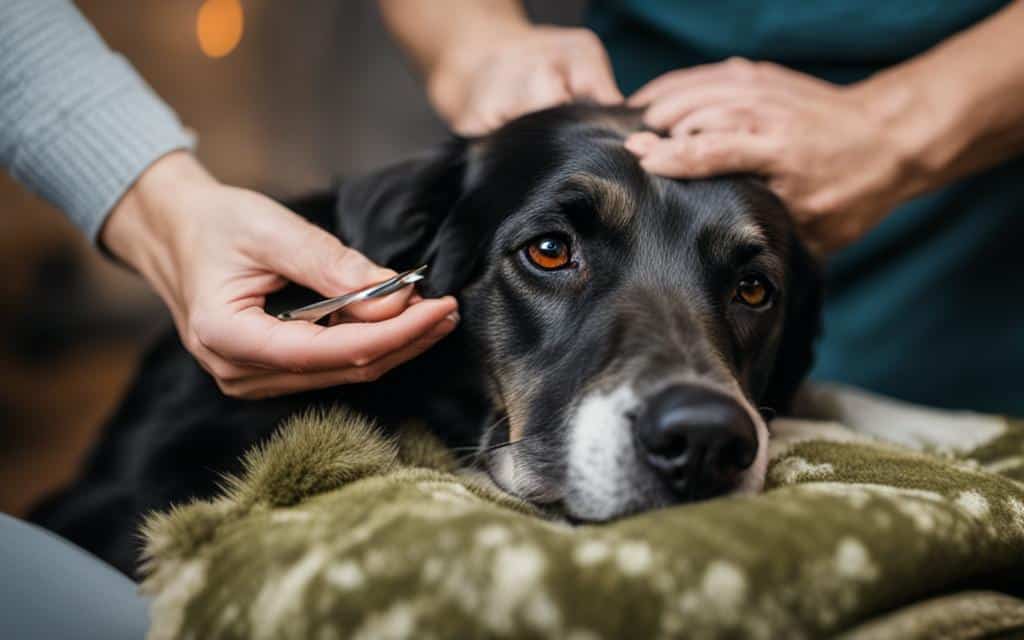
Comfortable Coat Styling
As senior dogs age, their fur may become thinner or more brittle, leading to discomfort during grooming sessions. To keep them looking and feeling their best, it’s important to prioritize gentle grooming techniques and consider coat styling options that minimize stress and discomfort.
Keeping Fur Shorter
One option for comfortable coat styling is to keep the fur shorter. This can prevent mats and tangles from forming, which can be painful for older dogs to detangle. A shorter coat can also be easier to maintain and keep clean, reducing the need for extensive brushing or grooming sessions.
Minimizing Heavy Grooming Products
Another way to prioritize comfort in coat styling is to minimize the use of heavy grooming products, such as hairspray or hair gel. These can weigh down the fur and make it more challenging for dogs to move or rest comfortably. Instead, consider using natural, lightweight products that won’t cause discomfort or irritation.
Considering Specific Hairstyles
Some hairstyles can be better suited to senior dogs than others. For example, a shorter “puppy cut” can be a great option for dogs with thinner fur, while long, flowing styles may not be as comfortable. Additionally, styles that require excessive grooming or styling may not be suitable for older dogs, who may have trouble standing or sitting for extended periods.
By prioritizing comfortable coat styling, pet owners can help their aging dogs look and feel their best while avoiding unnecessary discomfort or stress.
Addressing Mobility Issues
As dogs age, mobility can become a significant challenge, making it difficult for them to maintain a regular grooming routine. However, with a few simple adjustments, grooming can still be a comfortable experience for dogs with limited mobility.
First, it’s important to create a grooming area that’s easily accessible for your senior dog. If they struggle with stairs or high surfaces, consider using a ramp or placing a non-slip mat on the floor to prevent slipping. It’s also important to maintain a calm and quiet atmosphere during grooming to avoid further stress or discomfort.
Tip: You may also need to adjust the frequency of grooming sessions to suit your dog’s needs. Instead of long, exhaustive sessions, consider shorter, more frequent sessions to minimize discomfort and joint strain.
If your senior dog has trouble standing for extended periods, a grooming table or elevated surface may not be the best option. Instead, consider using a comfortable bed or mat for grooming sessions. This will allow your dog to lay down and relax while you groom them.
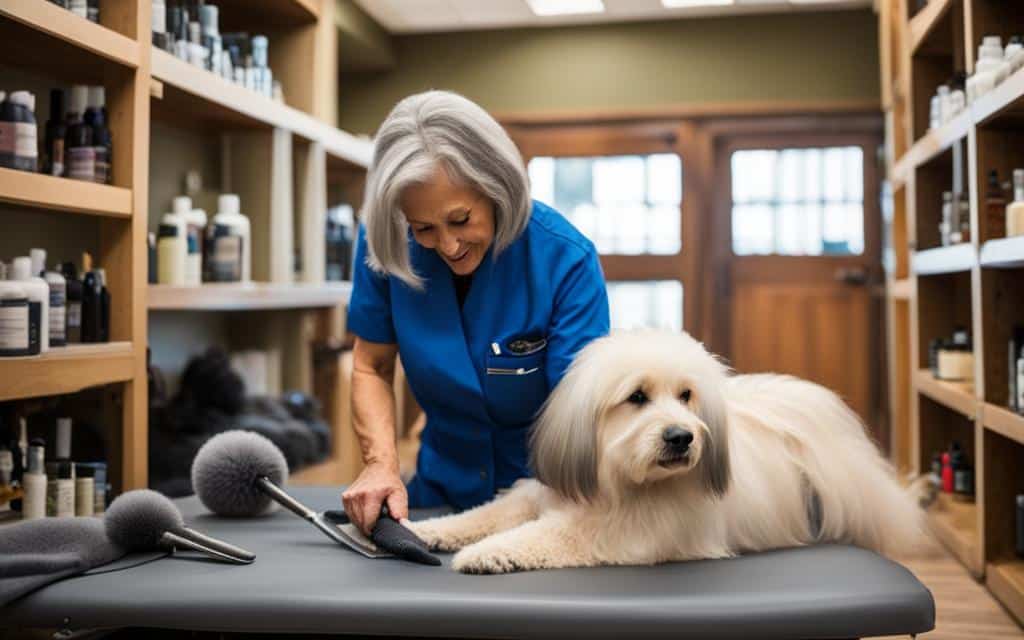
Finally, if your senior dog has particularly sensitive areas or painful joints, it may be best to avoid grooming those areas altogether. Consult with your veterinarian regarding special grooming techniques and products that can help minimize discomfort.
Dealing with Anxiety and Stress
Grooming can be a stressful experience for older dogs, and it is natural for them to feel anxious during a grooming session. However, it is important to minimize this stress as much as possible to make the experience as comfortable for the dog as possible.
One way to reduce stress is through desensitization. This involves gradually introducing your dog to grooming tools and equipment over time, so they become familiar with them and less scared.
Positive reinforcement can also be used to decrease stress during grooming. This involves rewarding your dog with treats or praise when they do something right and focusing on the positive aspects of each grooming session.
Calming aids are another useful tool for reducing stress during grooming. These can include aromatherapy, pheromone sprays, and calming music.
“Grooming should not be a traumatic experience for your aging pet. By taking a patient, gentle approach, and using techniques to minimize anxiety and discomfort, you can help your senior dog look and feel their best in their golden years.”
Seeking Professional Help
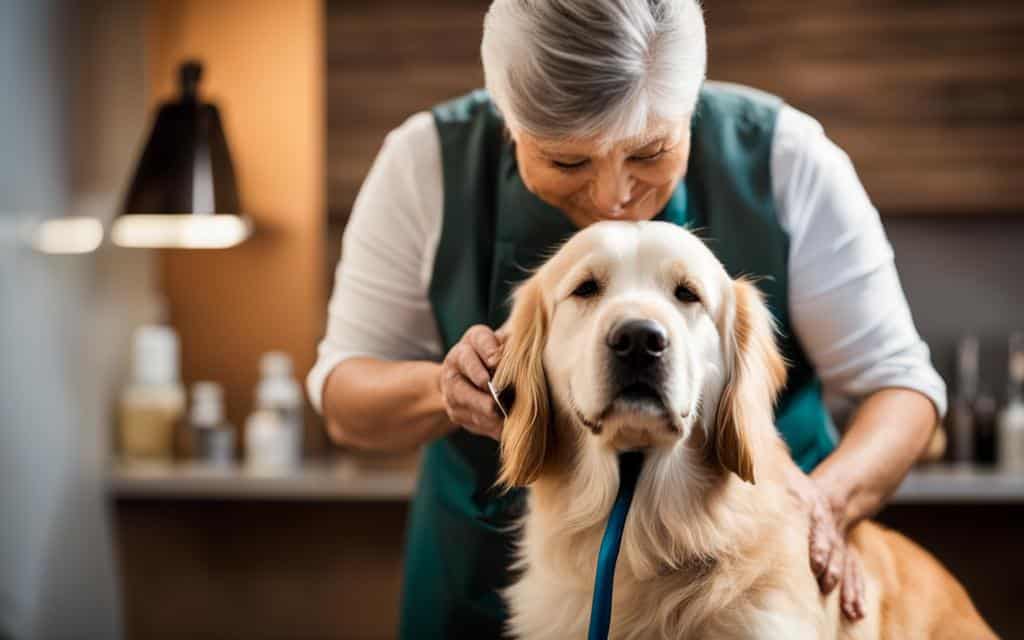
While grooming your senior dog at home is important, there may come a time when seeking professional help becomes necessary. Experienced groomers can help care for your aging pet’s unique needs and ensure they receive the appropriate services and treatments.
When looking for a groomer, it’s crucial to find someone with experience in senior dog care. Ask other pet owners, your veterinarian, or local animal shelters for recommendations. Once you have a list of potential groomers, research them online by reading reviews and testimonials from other customers.
When you’ve found a groomer you’re interested in, schedule a meeting to ask about their experience and training with senior dogs. Be sure to communicate any specific needs or concerns your dog may have, such as mobility issues or skin sensitivities. You may also want to ask what type of products and tools the groomer uses to ensure they align with your pet’s needs.
While seeking professional help may come at an additional cost, it can be worth it for the peace of mind in knowing your senior dog is receiving the best care possible.
Conclusion
Grooming for senior dogs is an essential part of their overall care and well-being. By understanding their unique needs and challenges, we can provide our aging companions with the compassionate grooming they deserve.
In this article, we have provided expert tips on how to create a gentle grooming routine, including bathing and drying delicately, nurturing the coat and skin, and addressing mobility issues. We have also emphasized the importance of maintaining the hygiene of the eyes, ears, and teeth, as well as seeking professional help when necessary.
Remember, grooming for senior dogs requires patience, compassion, and a deep understanding of their individual needs. By implementing the tips and techniques outlined in this article, you can ensure that your aging pet looks and feels their best in their golden years.
Thank you for taking the time to read our guide to grooming for senior dogs. We hope that you have found it informative and helpful in caring for your aging companion.
FAQ
Why is grooming important for senior dogs?
Grooming is essential for senior dogs as it helps maintain their overall health and comfort. Regular grooming promotes proper circulation, prevents matting and skin issues, and allows for early detection of potential health problems.
How often should I groom my senior dog?
The frequency of grooming for senior dogs may vary depending on their breed, coat type, and individual needs. Generally, aim to groom your senior dog at least once a week to keep their coat clean, free from tangles, and their skin healthy.
What grooming techniques should I use for my aging dog?
When grooming older dogs, it’s important to use gentle techniques to avoid causing any discomfort. Use softer brushes to avoid pulling or tugging on the coat, be patient during grooming sessions, and provide a calm and relaxing environment to minimize stress.
How can I make bathing and drying comfortable for my senior dog?
To make bathing and drying a pleasant experience for your senior dog, use mild shampoos that are specifically formulated for older dogs. Ensure the water temperature is comfortable, use a non-slip mat in the tub, and dry your dog thoroughly but gently with a towel or a low-heat blow dryer.
How can I care for my senior dog’s coat and skin?
Regular brushing is important for senior dogs to promote circulation and prevent matting. Trim any overgrown fur carefully and use moisturizers or specialized products to address dryness and itchiness. If you notice any skin issues, consult with your veterinarian for appropriate treatments.
How should I clean my senior dog’s eyes, ears, and teeth?
Clean your senior dog’s eyes with a damp cloth or eye wipes specifically made for dogs. Use a gentle ear cleaner and cotton pads to clean their ears, avoiding deep insertion. Brush your dog’s teeth regularly with a dog-friendly toothpaste and toothbrush or use dental wipes as recommended by your veterinarian.
How can I trim my senior dog’s nails without causing discomfort?
Nail trims can be challenging for senior dogs, so it’s important to trim their nails gradually and offer treats and praise as a positive reinforcement. If you’re uncomfortable doing it yourself, consider seeking help from a professional groomer or your veterinarian.
Are there specific coat styles suitable for senior dogs?
Yes, you can consider keeping your senior dog’s fur shorter to minimize matting and make grooming more manageable. Avoid using heavy styling products that can weigh down the coat. Consult with a professional groomer for hairstyle options that suit your dog’s comfort and needs.
How can I make grooming comfortable for my senior dog with mobility issues?
If your senior dog has mobility issues, consider grooming them in a comfortable and easily accessible area. Use ramps or steps if needed, and provide supportive cushions or mats to alleviate discomfort. Take breaks during grooming sessions and adjust your dog’s position as necessary.
What can I do to reduce anxiety and stress during grooming for my aging dog?
To reduce anxiety and stress during grooming, introduce positive associations by gradually familiarizing your dog with grooming tools and techniques. Use treats, praise, and rewards to create a positive grooming experience. Calming aids like pheromone sprays or calming music can also help alleviate anxiety.
When should I seek professional help for grooming my senior dog?
If you’re uncertain about grooming techniques or if your senior dog has special needs or medical conditions, it’s advisable to seek professional help. Look for groomers experienced in handling senior dogs and communicate your dog’s specific needs to ensure they receive the best care.

